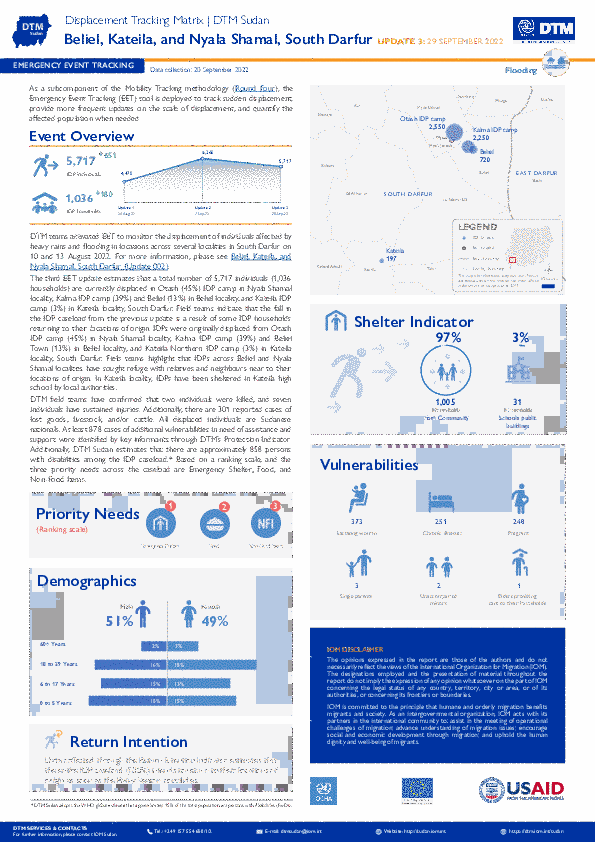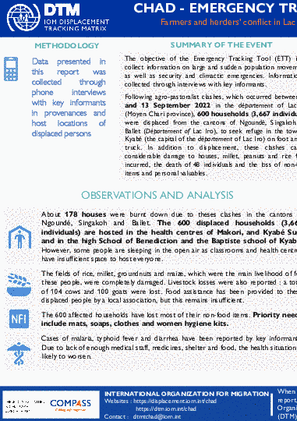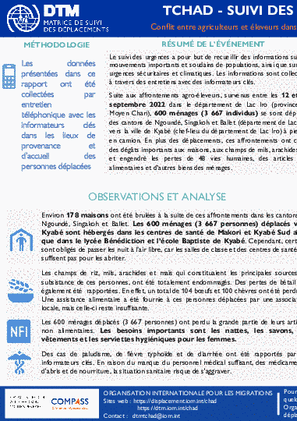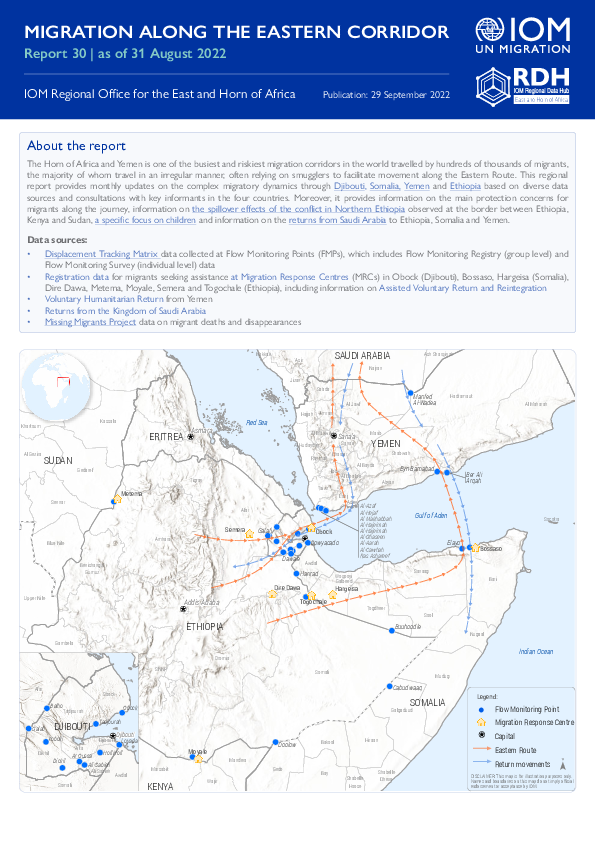-
Countries
-
Data and Analysis
-
Special Focus
-
Crisis Responses

Contact
DTM South Sudan, SouthSudanDTM@iom.int
Language
English
Location
South Sudan
Period Covered
Jan 01 2022
Mar 31 2022
Activity
- Flow Monitoring
IOM’s Displacement Tracking Matrix (DTM) continued conducting Displacement Site Flow Monitoring (DSFM) at the gates of Malakal PoC Site. During this period, 4,012 interviews were conducted representing 6,616 individual movements into / out of the PoC site. Day movements increased by 14 per cent during this quarter and were mainly dominated by female travelers (57%). Individuals who embark on day movements do so to tend to other livelihood activities including collecting elephant grass (43%) and carry out farming / fishing activities (20%). Temporary movements were driven by individuals moving out to visit friends / family (52%), attempting to return home (10%), and access to healthcare services (9%). Most individuals who traveled temporarily intend to spend more than 6 months (47%), with female travelers dominating these movements (64%). Malakal PoC site recorded a 9 per cent increase in new arrivals (193 to 211 individuals), and 56 per cent of whom were female. Travelers have cited the need to join family (35%) and access to general healthcare (30%) as the main drivers of these new arrivals, and 52 per cent of travelers intend to spend more than 6 months. Permanent exits increased from 41 to 44 individuals during the first quarter of 2022, the majority of whom were females (66%). Attempting to return home has been the main reason for leaving the PoC site, accounting for 77 per cent of exits. Most exits were destined to former homes (80%) in Panyikang, Manyo, and Fashoda counties.

Contact
DTM Sudan; dtmsudan@iom.int
Language
English
Location
Sudan
Snapshot Date
Sep 20 2022
Activity
- Mobility Tracking
- Event Tracking
As a subcomponent of the Mobility Tracking methodology (Round Four), the Emergency Event Tracking (EET) tool is deployed to track sudden displacement, provide more frequent updates on the scale of displacement, and quantify the affected population when needed.

Contact
DTM South Sudan, SouthSudanDTM@iom.int
Language
English
Location
South Sudan
Period Covered
Jan 01 2022
Mar 31 2022
Activity
- Flow Monitoring
IOM’s Displacement Tracking Matrix (DTM) continued conducting Displacement Site Flow Monitoring (DSFM) at the gates of Bentiu IDP camp. The first quarter of 2022 saw 9,694 interviews recorded accounting for 43,027 individuals moving into / out of the camp. Day movements increased by 56 per cent compared to the previous quarter and were dominated by women and girls (65%). Among all respondents, the main reason for day movements was to collect firewood (19%). Longer temporary movements were mainly driven by individuals moving out of the camp to visit friends / family (20%) and attempts to return home (15%), while short-time movements were to make / sell charcoal (15%), collect firewood (13%) and elephant grass (9%). Most temporary travelers intend to spend 2-3 months away in locations of destination. A 28 per cent decrease in surveyed new arrivals was recorded, most of whom were female (59%). Sixty-four per cent of individuals arrived from locations within Unity state. Of the new arrivals, 67 per cent of individuals intend to spend more than six months in the camp. Surveyed permanent exits recorded a 39 per cent increase compared to the last quarter of 2021, with most individuals exiting the camp to join their families (31%) and 28 per cent moving out because of improved living conditions in locations of destination. Half of the movements were destined to former homes in Rubkona, Leer and Guit counties.
The Horn of Africa and Yemen is one of the busiest and riskiest migration corridors in the world travelled by hundreds of thousands of migrants, the majority of whom travel in an irregular manner, often relying on smugglers to facilitate movement along the Eastern Route. This regional report provides monthly updates on the complex migratory dynamics through Djibouti, Somalia, Yemen and Ethiopia based on diverse data sources and consultations with key informants in the four countries. Moreover, it provides information on the main protection concerns for migrants along the journey, information on the spill over effects of the conflict in Northern Ethiopia observed at the border between Ethiopia, Kenya and Sudan, a specific focus on children and information on the returns from Saudi Arabia to Ethiopia, Somalia and Yemen.

Contact
DTM Mauritania, DTMMauritania@iom.int
Language
English
Location
Mauritania
Period Covered
Aug 01 2022
Aug 31 2022
Activity
- Survey
- Flow Monitoring Survey
- Flow Monitoring
La transhumance est une pratique de longue date en Mauritanie où elle a évolué au cours des dernières décennies avec la raréfaction des routes empruntées par les troupeaux notamment affectés par une raréfaction des ressources. Par conséquent, des conflits peuvent survenir entre les agriculteurs et les éleveurs transhumants. Dans le cadre du Suivi des Mouvements de Transhumance, l’OIM met en œuvre un système d’alerte qui a pour objectif de recenser les mouvements inattendus de bétail et les conflits ou catastrophes liés à l’utilisation des ressources naturelles et aux interactions entre agriculteurs et éleveurs, de comprendre les modes de résolution de conflits existants et d’informer les autorités compétentes, dans l’objectif de réduire et prévenir les tensions dans les régions d’intervention. Ce tableau de bord présente les informations fournies par le biais de 21 informateurs clés, présents dans huit régions (Assaba, Brakna, Gorgol, Guidimakha, Hodh El Chargui, Hodh El Gharbi, Tagant et Trarza) pendant le mois de Août 2022.

Contact
DTM Nigeria, AllUsersInDTMNigeria@iom.int
Language
English
Location
Nigeria
Period Covered
Sep 19 2022
Sep 25 2022
Activity
- Mobility Tracking
- Event Tracking
On 19 September, armed bandits reportedly attacked the communities Gwandi village and Maikurfuna village in Ungushi ward of Kebbe LGA in Sokoto state. The attacks affected 1,780 individuals and led to the displacement of 1,766 individuals from their respective communities to the Sobon Gari area and the UBE Tudu Wada Primary School, both situated in Kebbe East ward of Kebbe LGA. As a result of the attacks, 14 fatalities and 20 injuries were reported.
On 21 and 22 September, floods resulting from an overflow of the river Benue were reported in Wadata community of Ankpa/Wadata ward in Makurdi LGA and Adana community of Egba ward of Agatu LGA in Benue state. The floods affected 1,101 individuals and led to the displacements of 538 individuals from Wadata community to Ankpa community and 563 individuals from Adana community to neighbouring shelters. As a result of the floods, 2 fatalities and 12 injuries were reported.
Furthermore, on 22 September, armed herders reportedly attacked the Mchia community in Mbagber ward of Logo LGA in Benue state. This attack affected 841 individuals and led to the displacement of 821 individuals from Mchia community to NKST Primary School Anyiin IDP camp in Mbagber ward of Logo LGA. As a result of the attack, 20 fatalities and 23 injuries were reported.

Contact
DTM Nigeria, AllUsersInDTMNigeria@iom.int
Language
English
Location
Nigeria
Period Covered
Sep 19 2022
Sep 25 2022
Activity
- Mobility Tracking
- Event Tracking
The DTM Emergency Tracking Tool (ETT) is deployed to track and to collect information on large and sudden population movements, provide frequent updates on the scale of displacement and quantify the affected population when needed. As a sub-component of the Mobility Tracking methodology in Nigeria, ETT utilises direct observation and a broad network of key informants to capture best estimates of the affected population per location, enabling targeted humanitarian response planning.
Between 19 and 25 September 2022, a total of 2,535 new arrivals were recorded in locations in Adamawa and Borno States. The new arrivals were recorded at locations in Askira/Uba, Bama, Dikwa, Gwoza, Monguno, Damboa, Ngala and Kala Balge Local Government Areas (LGAs) of the most conflict-affected state of Borno and in Fufore, Gombi, Girei, Hong, Maiha, Michika, Mubi South, Lamurde, Song, Numan, Yola North and Yola South LGAs of Adamawa State.

Contact
DTM Chad, dtmtchad@iom.int
Language
English
Location
Chad
Period Covered
Sep 23 2022
Sep 23 2022
Activity
- Mobility Tracking
- Event Tracking
Following agro-pastoralist clashes, which occurred between 12 and 13 September 2022 in the département of Lac Iro (Moyen Chari province), 600 households (3,667 individuals) were displaced from the cantons of Ngoundé, Singakoh and Ballet (Département of Lac Iro), to seek refuge in the town of Kyabé (the capital of the département of Lac Iro) on foot and by truck. In addition to displacement, these clashes caused considerable damage to houses, millet, peanuts and rice fields incurred, the death of 48 individuals and the loss of non-food items and personal valuables.

Contact
DTM Chad, dtmtchad@iom.int
Language
French
Location
Chad
Period Covered
Sep 23 2022
Sep 23 2022
Activity
- Mobility Tracking
- Event Tracking
Suite aux affrontements agro-éleveurs, survenus entre les 12 et 13 septembre 2022 dans le département de Lac Iro (province du Moyen Chari), 600 ménages (3 667 individus) se sont déplacés des cantons de Ngoundé, Singakoh et Ballet (département de Lac Iro) vers la ville de Kyabé (chef-lieu du département de Lac Iro) à pied et en camion. En plus des déplacements, ces affrontements ont causé des dégâts importants aux maisons, aux champs de mils, arachides, riz et engendré les pertes de 48 vies humaines, des articles non alimentaires et d’autres biens des ménages.
To better understand and capture how COVID-19 has been affecting global mobility, IOM developed a global database (the Mobility Restriction Monitoring, MRM) which maps, tracks, and analyses the changes and trends in operational status of and mobility restrictions at Points of Entry (PoEs) including airports, blue border crossing points (such as seaports and river crossings), land border crossing points and other key transit points and locations of internal mobility. Outside of operational status for key loca- tions of internal mobility, MRM collects data on border management and public health measures adopted at PoEs, as well as coordination systems and referral mechanisms in place at Points of Entry and some internal mobility points, as well as populations impacted by COVID-19 mobility restrictions.
Such information is meant to serve IOM member states, IOM, and its UN partner agencies in responding adequately, and in a targeted manner, to the current and evol- ving crisis period. In West and Central Africa, IOM missions were involved in providing information on the situation at the PoEs in their respective countries.
This report presents the findings from data collected on the operational status of PoEs as of 30 June 2022, with 573 Points of Entry across the region, including 417 land border crossings points, 74 airports and 82 blue border crossing points (maritime borders).

